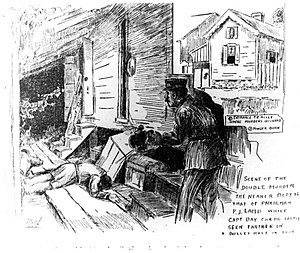New Orleans Race Riot of 1900
| Robert Charles riots | |||
|---|---|---|---|

Sketch of the scene at Robert Charles' residence on the 2000 block of Fourth Street.
|
|||
| Date | July 23 – July 28, 1900 | ||
| Location | New Orleans, Louisiana, United States | ||
| Caused by | White reaction to killing of white policemen | ||
| Goals | Suppression of blacks | ||
| Methods | Rioting, looting, assault, arson, property damage, firefights, murder | ||
| Parties to the civil conflict | |||
|
|||
| Lead figures | |||
|
|||
| Casualties | |||
| Death(s) | 21+ (mostly blacks; 28 | ||
| Injuries | 61 (mostly blacks) | ||
The Robert Charles riots of July 24-27, 1900 in New Orleans, Louisiana were sparked after African-American laborer Robert Charles fatally shot a white police officer during an altercation and escaped arrest. A large manhunt for him ensued, and a white mob started rioting, attacking blacks throughout the city. The manhunt for Charles began on Monday, July 23, 1900, and ended when Charles was killed on Friday, July 27, shot by a special police volunteer. The mob shot him hundreds more times, and beat the body.
White rioting continued, with several blacks killed after Charles had died. A total of 28 people were killed in the riots, including Charles. More than 50 people were wounded in the riots, including at least 11 who had to be hospitalized. Blacks made up most of the fatalities and casualties.
Robert Charles (b. circa 1865) had come to New Orleans from Mississippi. He was a self-educated activist for civil rights. He believed in self-defense for the African-American community and, after Democrats stole the 1896 election, encouraged African Americans to move to Liberia to escape racial discrimination and violence.
Louisiana was a slave society before the American Civil War, with hundreds of enslaved people working on each of numerous large cotton and sugar cane plantations, and many others in smaller groups, including in port cities such as New Orleans. Some also worked on the steamboats that traveled the rivers. At the start of the 20th century, the population of New Orleans was recorded in 1900 at 730,000 'white' and 650,000 'negro' by the Twelfth Census of the United States. Among the latter were many mixed-race people, most of whose ancestors had formerly had a distinct status as free people of color before the Civil War, particularly during the years of French and Spanish control. They are also known as Creoles of color.
The white-dominated legislature, primarily Democrats, had passed a new state constitution in 1898 with provisions that disenfranchised most African Americans by making voter registration more difficult, through poll taxes, literacy tests and similar measures. After that, the Democratic-dominated legislature passed eight Jim Crow laws by 1900. These included a law establishing racial segregation for public facilities, including interstate railroad cars, which were nominally under federal law. Plessy vs. Ferguson (1896) was a Louisiana test case of segregation on interstate railroad cars, which was appealed to the US Supreme Court. Opponents argued that federal laws and constitutional rights should apply on interstate transportation, but the Court ruled the state could establish "separate but equal" facilities. In practice, however, the "separate" facilities were seldom equal.
...
Wikipedia
